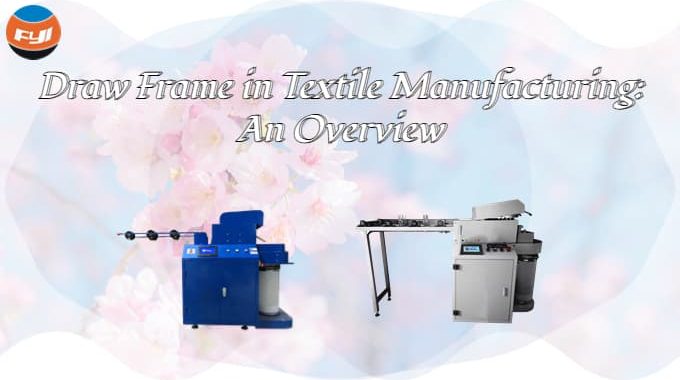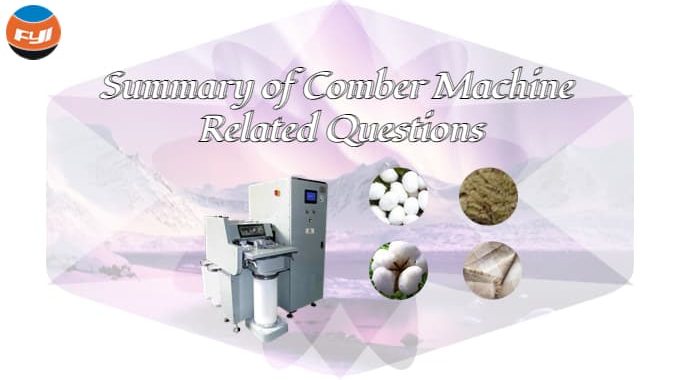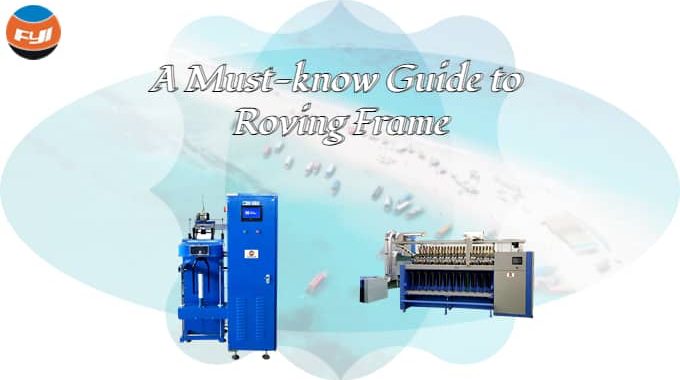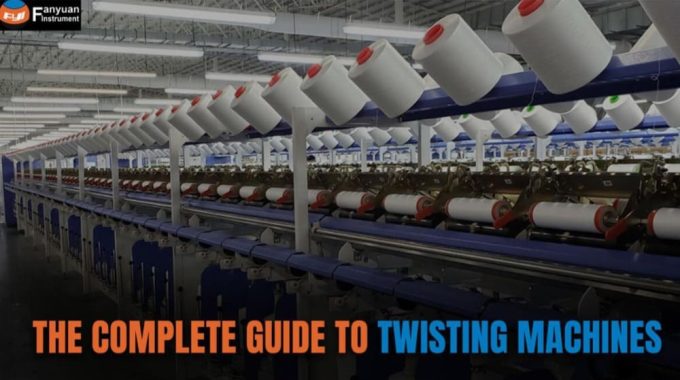
The Complete Guide to Twisting Machines
What turns a simple yarn into a strong, high-performance fabric? How do modern textiles meet today’s tough standards? – The answer lies in twisting machines.
Twisting machines are the key to modern textile production. They turn basic yarns into strong, high-quality materials that meet today’s standards. These machines shape the strength, look and use of textiles in many industries.
If you work in research, teaching or textile production, knowing how twisting machines work is crucial. Whether you’re checking quality, designing products or choosing equipment, yarn twisting knowledge helps you succeed in a fast moving market.
This guide covers all you need to know about twisting machines. From how they work to the latest testing methods. See how double twist machines are increasing output without compromising the high quality the textile world expects.
Contents
- 1 Understanding Twisting Machine Technology
- 2 What is Twisting?
- 3 Types of Twisting Machines
- 4 Working Principles and Testing Methods
- 5 Performance Parameters and Technical Specifications
- 6 Industry Standards and Compliance
- 7 Applications and Industry Uses of Twisting machines
- 8 Cost-Effectiveness and Maintenance
- 9 Conclusion
- 10 FAQs
Understanding Twisting Machine Technology
Modern twisting technology is a big step forward from traditional textile manufacturing methods. Today’s systems combine precision engineering with electronic controls to deliver unprecedented accuracy and efficiency in yarn processing.
The basic principle behind all twisting operations is combining multiple single yarns into plied structures with improved properties. This creates stronger, more versatile materials that can withstand the demands of various textile applications.
What is Twisting?
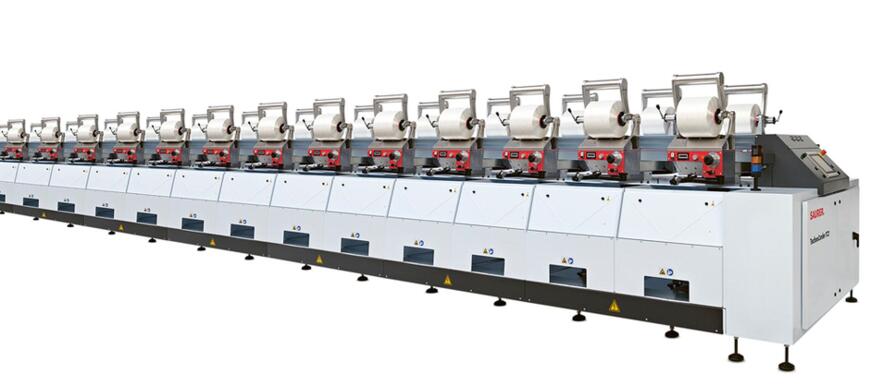
Twisting is the systematic process of combining two or more single yarns through controlled rotation to create plied yarns with better properties. This process fundamentally changes the yarn’s structure, creating helical fibre arrangements that improve strength, uniformity and performance.
The twisting process happens in two stages. First multiple yarns are combined on a spinning machine to ensure proper tension and alignment. Second the combined yarns pass through a twisting machine where controlled rotation creates the desired twist level and direction.
Modern twisting systems can achieve incredible precision, with twist accuracy within ±2% of target values. This level of control ensures consistent yarn properties throughout production runs so you can meet the strict specifications for technical textiles and high performance applications.
Types of Twisting Machines
Knowing the different types of twisting machines helps you choose the right equipment for your application and production requirements.
| Machine Type | Max Speed (RPM) | Twists per Revolution | Primary Application |
| Ring Twisting | 8,000-10,000 | 1 | Natural fibers, traditional yarns |
| Double Twist | 12,000+ | 2 | High-efficiency production |
| Two-for-One | 10,000-12,000 | 2 | High-volume plied yarns |
| Laboratory | 12,000 | 1-2 | Research and development |
1. Ring Twisting Machines
Ring twisting machines are the traditional way of twisting yarn, using ring and traveller systems to create twisted structures. These machines work through mechanical transmission systems where one motor powers spindles, winding mechanisms and traverse systems through belt drives and gear arrangements.
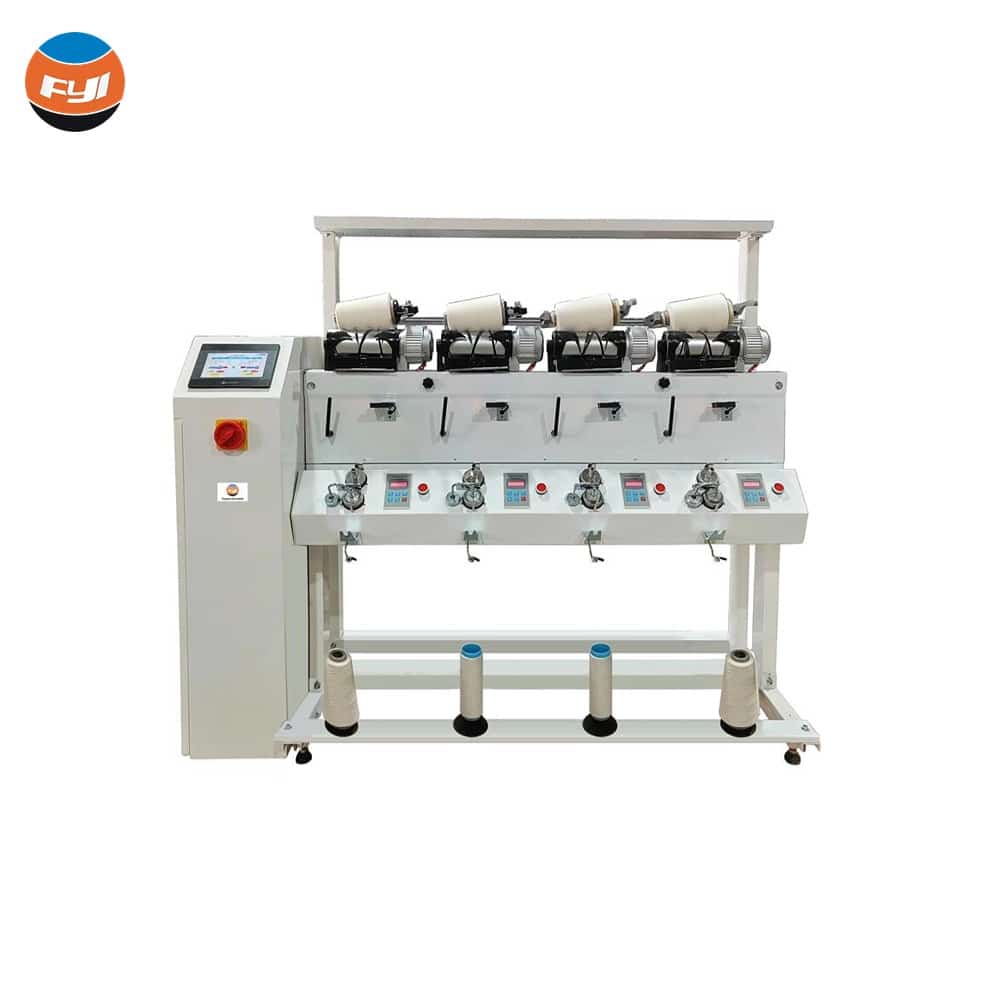
Ring twisting machines are the traditional way of twisting yarn, using ring and traveller systems to create twisted structures. These machines work through mechanical transmission systems where one motor powers spindles, winding mechanisms and traverse systems through belt drives and gear arrangements.
The main advantage of ring twisting machines is their simplicity and reliability. These systems require minimal electronic controls and can work in any environmental conditions. However their production speed is limited by traveller dynamics, typically up to 8,000-10,000 rpm.
Ring systems are good for natural fibres and traditional yarns where moderate production speeds are acceptable. The mechanical nature of these machines makes them suitable for facilities with limited technical support, as maintenance requirements are focused on basic mechanical components rather than complex electronic systems.
2. Double Twist Machines

Double twist machines revolutionise yarn processing by achieving two twists per spindle revolution, doubling productivity compared to single twist systems. These machines eliminate the ring and traveller mechanism, removing speed limitations and allowing spindle speeds up to 12,000 rpm or more.
Double twist machines revolutionise yarn processing by achieving two twists per spindle revolution, doubling productivity compared to single twist systems. These machines eliminate the ring and traveller mechanism, removing speed limitations and allowing spindle speeds up to 12,000 rpm or more.
The key innovation in double twist technology is the yarn path configuration, where the yarn passes through a rotating spindle that imparts twist while simultaneously winding the twisted yarn onto a package. This design creates two twist insertions for each spindle rotation, greatly increasing production efficiency.
Modern double twist machines have sophisticated electronic control systems with PLC based controllers and touch screen interfaces. These systems allow precise adjustment of spindle speed, winding speed and traverse motion, giving unprecedented control over yarn properties and package formation.
3. Two-for-One Twisting Machines
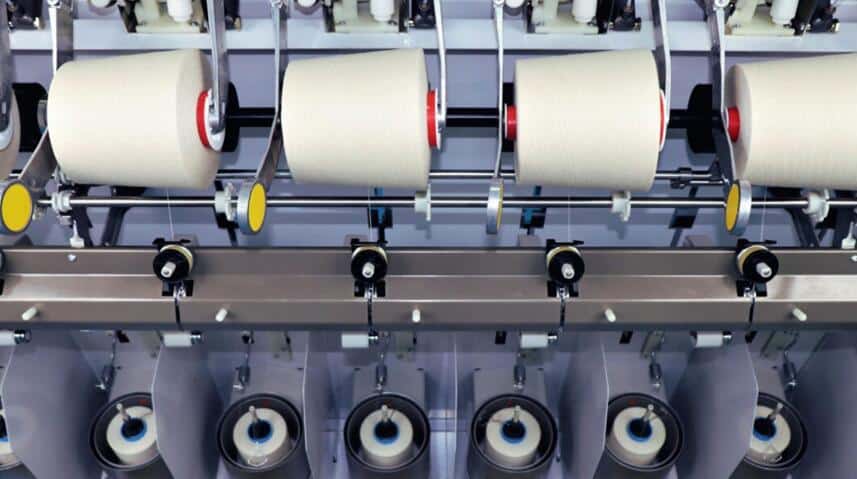
Two-for-one twisting machines, also known as Volkmann-type machines, are a special category designed for high efficiency production of plied yarns. These machines achieve their name from the ability to insert two twists for each revolution of the twisting element, similar to double twist machines but with different mechanical arrangements.
The main advantage of two-for-one machines is the ability to process multiple yarn ends simultaneously while maintaining consistent tension and twist distribution. These machines are good for producing uniform plied yarns for applications that require precise twist levels and excellent uniformity characteristics.
Two-for-one systems have automatic tension control, package building optimisation and integrated quality monitoring. These features make them ideal for high volume production environments where consistency and efficiency are top priority.
4. Laboratory Twisting Machines
Laboratory twisting machines are used in research, development and quality control applications. These systems provide a controlled environment to test different twist parameters, new fibers and optimize production processes before full scale implementation.
FYI Tester offers laboratory twisting solutions, the DW7051H Lab Twisting Machine has 6-12 spindles with speed range 100-12,000 rpm. These systems have touch screen controls, PLC based automation and precise parameter adjustment for research applications.

Laboratory machines enable systematic testing of twist effects on yarn properties, strength, elongation and structural characteristics. This testing is very useful for product development, quality assurance and process optimization in various textile applications.
Working Principles and Testing Methods
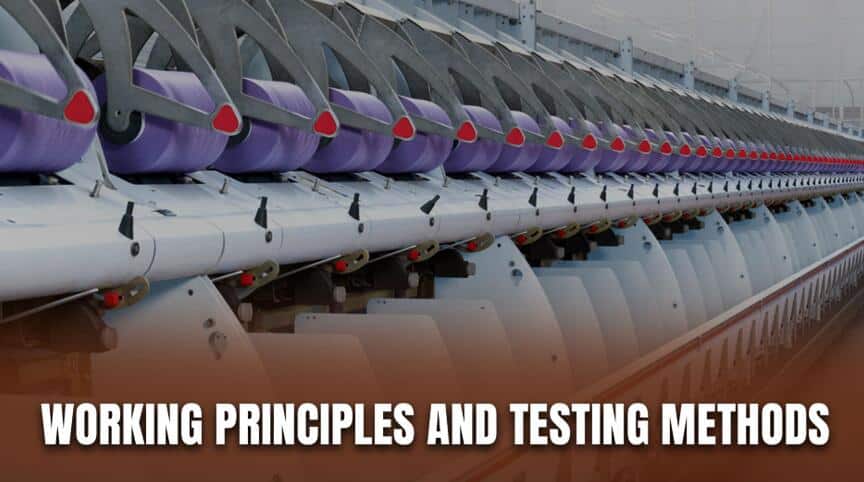
The science behind twisting is complex mechanical and physical principles that determine final yarn characteristics. Understanding these principles allows optimization of processing parameters and achieve desired yarn properties.
Modern testing methods provide accurate measurement and verification of twisting results, ensuring consistent quality and compliance to industry standards.
1. Fundamental Operating Principles
Twisting creates helical fiber arrangements in yarn structures, fundamentally changing their mechanical properties. When fibers are arranged in helical configuration around the yarn axis, they create a self-locking effect that improves yarn strength and coherence.
This self-locking mechanism occurs because twisted fibers under tension create radial pressure that compacts the yarn structure. The increased normal force between fibers enhances frictional resistance to slippage, creating the mechanical integrity for subsequent processing and end-use applications.
The relationship between twist and yarn count is well established.
The twist factor (K) is the relationship between twist and yarn count, K = T × √N, where T is turns per meter and N is yarn count.
This allows to predict the optimal twist for different yarns and applications.
2. Modern Control Systems
Modern twisting machines have sophisticated electronic control systems that provide unprecedented precision and flexibility. PLC based controllers with touch screen interfaces allow to set and monitor critical parameters like spindle speed, twist level and package formation.
Servo motor technology provides high positioning accuracy, typically ±1% of target value. This is essential for applications that require specific twist angle, package profile or yarn handling characteristics. Frequency converter systems allow stepless speed regulation, to optimize processing parameters for different yarns and quality requirements.
Advanced systems have real-time monitoring capabilities to monitor yarn tension, twist level and package formation quality. These monitoring systems can adjust processing parameters automatically to maintain optimal conditions, reduce variability and increase overall production efficiency.
3. Testing Methods and Standards
Testing of twisted yarns requires specialized equipment and standardized procedures to get reliable and reproducible results. The main testing methods are twist measurement, tension analysis and structural evaluation.
Twist Measurement Techniques: The untwist-retwist method is the standard method for measuring twist in staple fiber yarns. This involves completely removing twist from a yarn sample and then retwist in the opposite direction until the original length is restored. The total rotation count divided by two gives the actual twist level.
Modern automatic twist testers simplify this process while improving accuracy and repeatability. These systems have precise length measurement, automatic tension control and digital counting that eliminate operator variables and measurement errors.
Tension Analysis Procedures: Tension measurement during twisting requires specialized instrumentation to monitor in real-time throughout the process. Standard testing protocols specify tension levels of 5-10 mN/tex for single worsted yarns, depending on fiber type and yarn structure.
Consistent tension control is crucial to achieve uniform twist distribution and prevent yarn breakage during processing. Advanced systems have automatic tension compensation that adjusts feed rates and winding speeds to maintain optimal tension levels regardless of yarn variations or processing conditions.
Performance Parameters and Technical Specifications
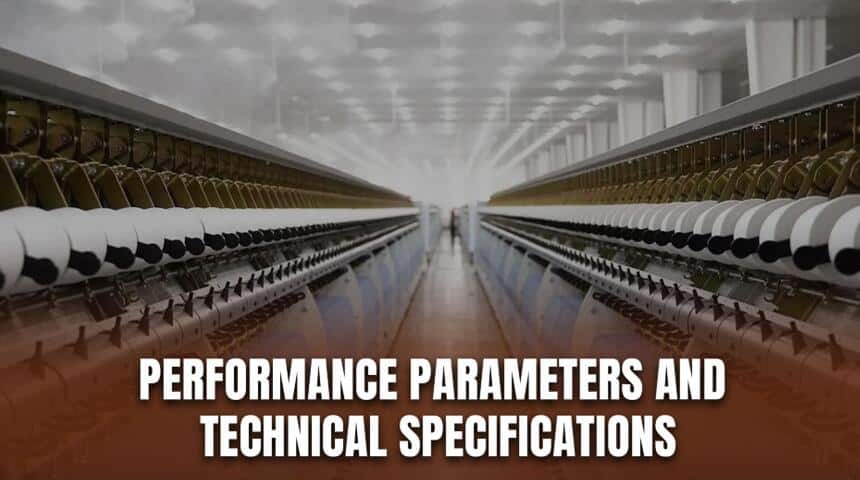
Equipment performance evaluation requires analysis of multiple technical parameters that affect production efficiency, yarn quality and operational reliability. Understanding these specifications helps to choose the right equipment and optimize processing conditions.
Modern twisting systems achieve high performance through combination of advanced mechanical and electronic technologies.
1. Key Performance Indicators
Spindle speed is the primary performance indicator for twisting equipment, modern systems can reach up to 12,000 rpm with precise control accuracy. This high speed combined with double twist functionality increases productivity by 100% or more compared to traditional systems.
Twist accuracy is another key specification, typically within ±2% of target value for premium equipment. This becomes more and more important for technical textiles and high performance applications where yarn uniformity directly affects end-product functionality.
Package building capability affects production efficiency and downstream processing requirements. Modern systems can build large packages directly, eliminating intermediate winding and reducing handling. Package weights of 2-5 kg are common, compared to 200-500g packages from traditional ring systems.
2. Electronic Features
Modern twisting machines perform better through extensive electronic integration and automation. Servo motor systems with high precision encoders allow rapid start-stop cycles and accurate positioning for traverse mechanisms, arbitrary adjustment of winding angles and yarn stacking patterns.
PLC control systems with touch screen interfaces provide full parameter control and monitoring. Operators can input technical parameters like spindle rotation speed, twist values and twist direction digitally while monitoring machine status in real-time. Multi-language capability allows international equipment deployment and operator training.
Energy efficiency is a major advantage of modern electronic systems. Variable frequency drives allow energy efficient operation by matching motor output to actual load, potentially reducing power consumption by 20-30% compared to fixed speed mechanical systems while providing better control.
| Performance Parameter | Traditional Ring | Double Twist | Laboratory Systems |
| Max Spindle Speed | 8,000 RPM | 12,000+ RPM | 12,000 RPM |
| Twist Accuracy | ±5% | ±2% | ±1% |
| Package Weight | 200-500g | 2-5 kg | 100-200g |
| Energy Efficiency | Baseline | +25-30% | +20-25% |
3. Quality Control
Advanced twisting systems have integrated quality monitoring that monitors yarn properties during production. These systems include tension monitoring, twist level verification and automated defect detection that allows process adjustments when deviations occur.
Statistical process control requires data logging capabilities to track key parameters over extended periods. Modern systems generate reports of production conditions, quality metrics and operational efficiency that are valuable for process optimization and quality certification.
For full quality assessment and research applications, laboratory systems like those from FYI Tester’s twisting machine collection provide controlled environment for parameter optimization and quality validation across different fibers and processing conditions.
Industry Standards and Compliance
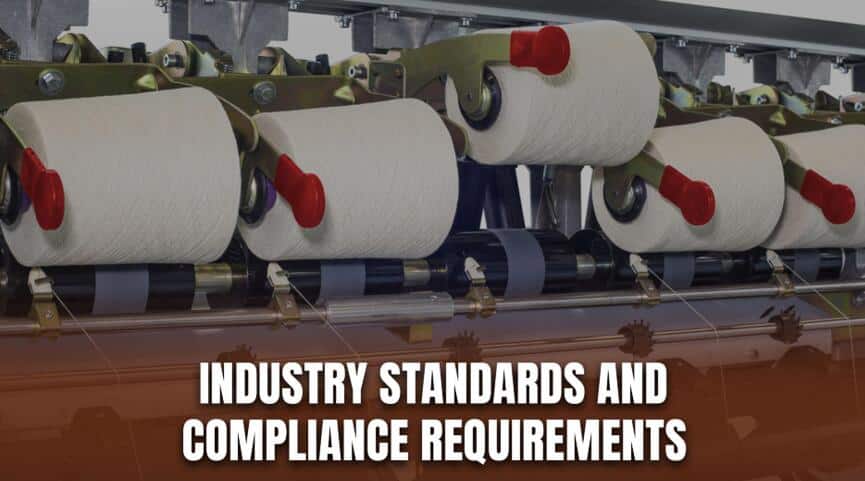
Textile industry operates under comprehensive standards that ensure consistent testing methods and quality assessment procedures across global markets. Compliance to these standards is necessary for market access and customer acceptance in today’s competitive world.
Understanding and implementing standards is the foundation for quality management systems and continuous improvement in textile operations.
1. International Testing Standards
ASTM D1422 establishes fundamental test methods for twist measurement in single yarns, providing detailed procedures for sample preparation, testing conditions, and result interpretation. This standard specifies environmental conditions of 21±1°C temperature and 65±2% relative humidity that must be maintained during testing to ensure reproducible results.
ISO 2061 provides international specifications for twist determination, it emphasizes the untwist-retwist method for staple fiber yarns and direct counting method for continuous filament applications. The standard includes specific requirements for sample length, testing tension and statistical analysis that must be included in testing protocol.
These standards are the technical basis for quality control programs and allow comparison of results between different laboratories and testing facilities. Compliance to international standards facilitates global trade and customer confidence in product quality and consistency.
2. Equipment Certification
Twisting machine manufacturers must demonstrate compliance to relevant safety and performance standards before deployment in commercial use. CE marking requirements in European market means conformity to essential health and safety requirements, including electromagnetic compatibility and machinery safety directives.
Electrical safety standards like IEC 60204-1 specify requirements for electrical equipment of machines, it covers control circuits, protection devices and operator interfaces. These standards ensure that electronic control systems meet the safety level and provide the necessary functionality for modern twisting operation.
Calibration and validation protocols require regular verification of critical measurement systems. Spindle speed accuracy, tension measurement systems and twist counting mechanism must be calibrated against traceable standards to maintain measurement uncertainty within the limit for quality certification purpose.
3. Quality Management
ISO 9001 quality management system requirements impact twisting machine operation and maintenance procedures. Equipment must operate within validated parameters, regular maintenance must be performed according to documented procedure to ensure consistent performance and product quality.
Documentation requirements go beyond basic operating procedure to include comprehensive records of maintenance activities, calibration results and process capability studies. These records provide traceability for quality investigation and support continuous improvement initiatives that drive operational excellence.
Risk assessment procedure evaluates the potential failure mode in twisting equipment and its impact on product quality. This analysis drives preventive maintenance strategy and operator training requirement that minimize quality risk and ensure consistent production outcome.
Applications and Industry Uses of Twisting machines
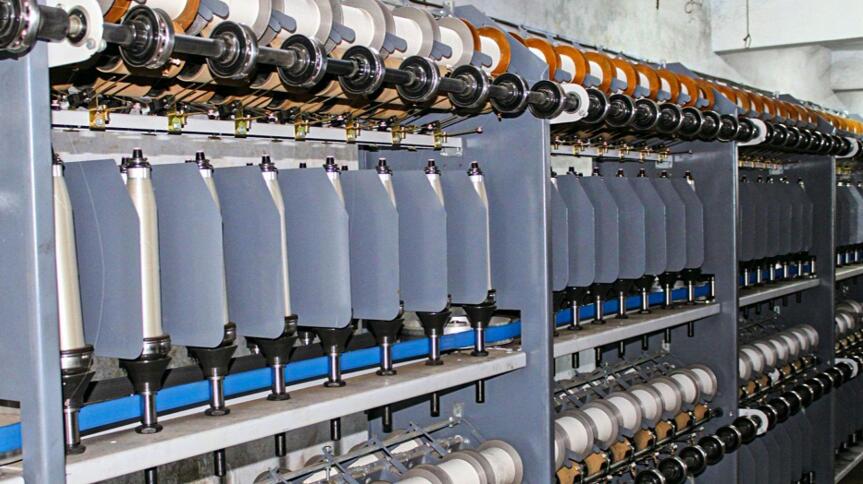
Twisting machines are used in various applications across different industries, from traditional textile manufacturing to advanced technical applications. Understanding these applications helps to identify the right equipment configuration and processing parameter for specific requirement.
The versatility of modern twisting technology allows processing of different fibers and creation of specialized yarn structure for demanding applications.
- Apparel: For strong, durable and aesthetic fabrics
- Home textiles: Bedding, upholstery, rugs and decorative fabrics
- Industrial textiles: Conveyor belts, filtration media and protective fabrics
- Automotive: Airbags, interior fabrics and composite reinforcements
- Medical textiles: Sutures, implants and wound care products
- Smart textiles: Conductive yarns and sensor-integrated fabrics
Cost-Effectiveness and Maintenance

Investment in twisting equipment requires thorough analysis of initial costs, operational expenses and long term value. Understanding these economic factors enables informed decision making and optimization of equipment utilization throughout its life.
Modern twisting systems offer significant operational benefits that often justify higher initial investment through improved productivity, quality and efficiency.
1. Cost Analysis
Initial equipment cost varies greatly based on technology level, production capacity and feature requirements. Traditional ring twisting machines require lower initial investment but may have higher operational cost due to energy consumption and productivity limitations.
Double twist machines command higher prices due to advanced electronic controls and precision engineering but productivity benefits often justify these investments through lower per-unit production cost. Ability to achieve two twists per spindle revolution effectively doubles production capacity while utilizing same floor space and operator resources.
Labour cost favours automated systems with advanced control interface that reduce operator skill requirement while improving process consistency. Touch screen controls and automated parameter adjustment minimizes setup time and reduce operator variation impact on product quality.
2. Maintenance Strategy
Effective maintenance program addresses both mechanical and electronic system components through scheduled inspection, lubrication and replacement. Critical mechanical elements like spindles, bearings and drive systems require regular attention according to manufacturer specification to ensure reliable operation.
Spindle bearing life typically ranges from 8,000-12,000 hours under normal condition, actual life depends on operating speed, load condition and maintenance practice. Regular lubrication and contamination prevention extends bearing life and reduce maintenance cost.
Electronic system maintenance focuses on control panel cleanliness, connection integrity and software update. PLC systems require minimal maintenance but benefit from periodic backup of control program and parameter setting to prevent data loss during component failure.
Predictive Maintenance Techniques: Advanced maintenance approach uses condition monitoring to predict component failure before it happens. Vibration monitoring of high speed spindles can detect bearing deterioration early, enabling planned replacement during scheduled maintenance window rather than emergency repair.
Temperature monitoring of electrical components gives early warning of potential failures in drive systems and control circuits. These monitoring systems enable optimization of maintenance schedules and reduction of unplanned downtime that disrupts production schedules and increases costs.
3. Total Cost of Ownership
Total cost of ownership must consider training, installation, commissioning and long term support costs beyond purchase price. Installation complexity varies greatly between equipment types, modern electronic systems require specialized technical support for proper commissioning and parameter optimization.
Service and support availability has a big impact on long term operational costs. Equipment suppliers with local service capabilities provide faster response times and lower service costs compared to suppliers that require remote technical support. Annual service contracts can provide cost predictability and access to technical expertise when needed.
Technology advancement considerations affect long term equipment value and competitiveness. While electronic controls provide better functionality and efficiency, they may require periodic updates to maintain optimal performance and compatibility with industry requirements.
Conclusion
Twisting machines are essential for producing high quality yarns in both traditional and technical textiles. Choosing the right equipment ensures better performance, quality and efficiency, modern machines and lab systems support production and innovation.
FYI Tester is ready to support your twisting machine requirements with complete solutions ranging from lab equipment to testing systems. Our expertise in textile testing technology ensures you get the right equipment and technical support for your specific applications and quality targets.
Visit our twisting machine collection to see our full range of testing equipment and technical support services for textile professionals.
Ready to boost your yarn processing? Contact FYI Tester today to discuss your twisting machine requirements and find out how our testing solutions can optimize your textile manufacturing.
FAQs
Q: What is the main difference between single twist and double twist machines?
Double twist machines do two twists per spindle revolution, effectively doubles the productivity of single twist machines. They also eliminate ring and traveler mechanisms, allows higher operating speed and better efficiency while maintaining quality control.
Q: How do I determine the optimal twist level for specific yarn applications?
Optimal twist levels depends on fiber type, yarn count and end use requirements. The twist factor formula (K = T × √N) is a starting point, but testing with lab equipment like DW7051H helps to optimize parameters for specific applications and quality targets.
Q: What maintenance is required for modern twisting machines?
Regular maintenance includes spindle bearing lubrication, electronic system cleaning and periodic calibration of control systems. Preventive maintenance programs typically schedule inspections every 500-1000 hours, major overhauls at 8,000-12,000 hours.
Q: Can twisting machines process different fibers?
Yes, modern twisting machines can process various fibers like cotton, polyester, nylon and specialty fibers. However, processing parameters need to be optimized for each fiber type to get optimal quality and prevent damage during processing.
Q: What are the key factors affecting twisting machine productivity?
Main factors are spindle speed capability, package size, yarn breakage rates and setup/changeover times. Double twist technology, large package capacity and automated controls improves overall productivity compared to traditional systems.
Q: How important is environmental control for twisting?
Environmental conditions affects yarn behavior and processing quality. Standard testing conditions is 21±1°C and 65±2% RH, production environment should be similar for optimal results and reduced yarn breakage.
